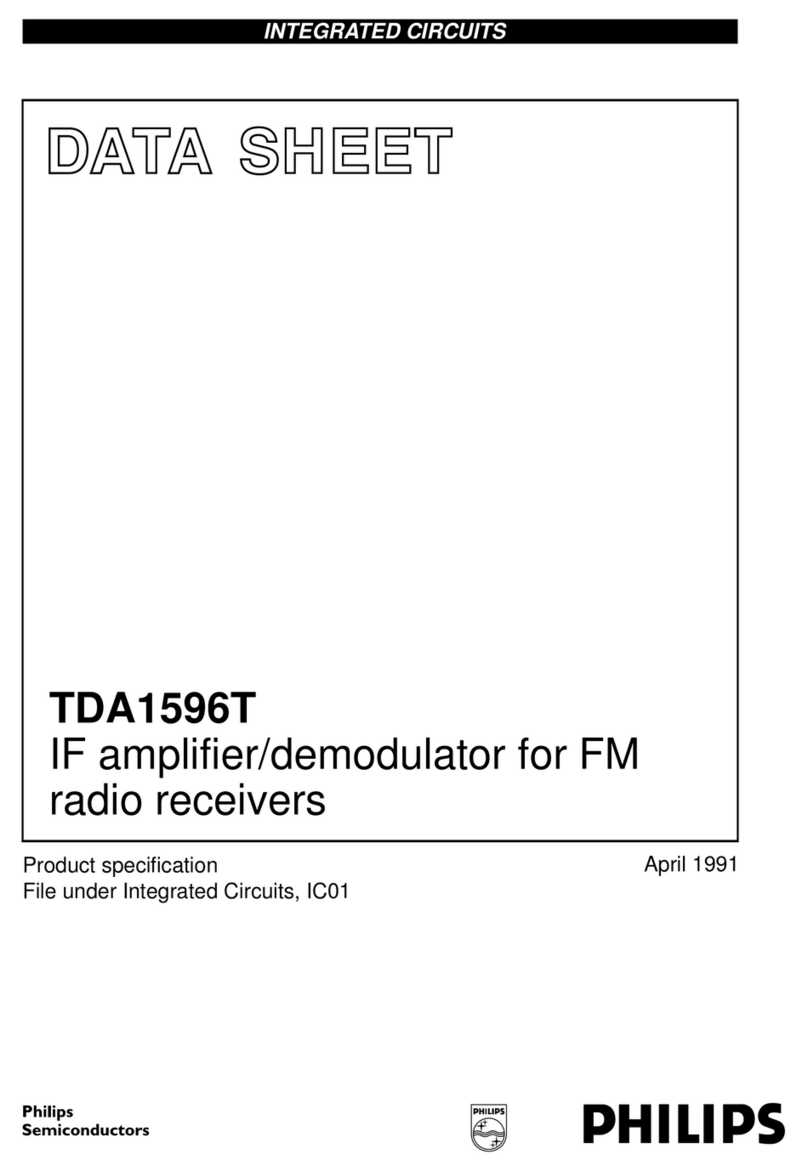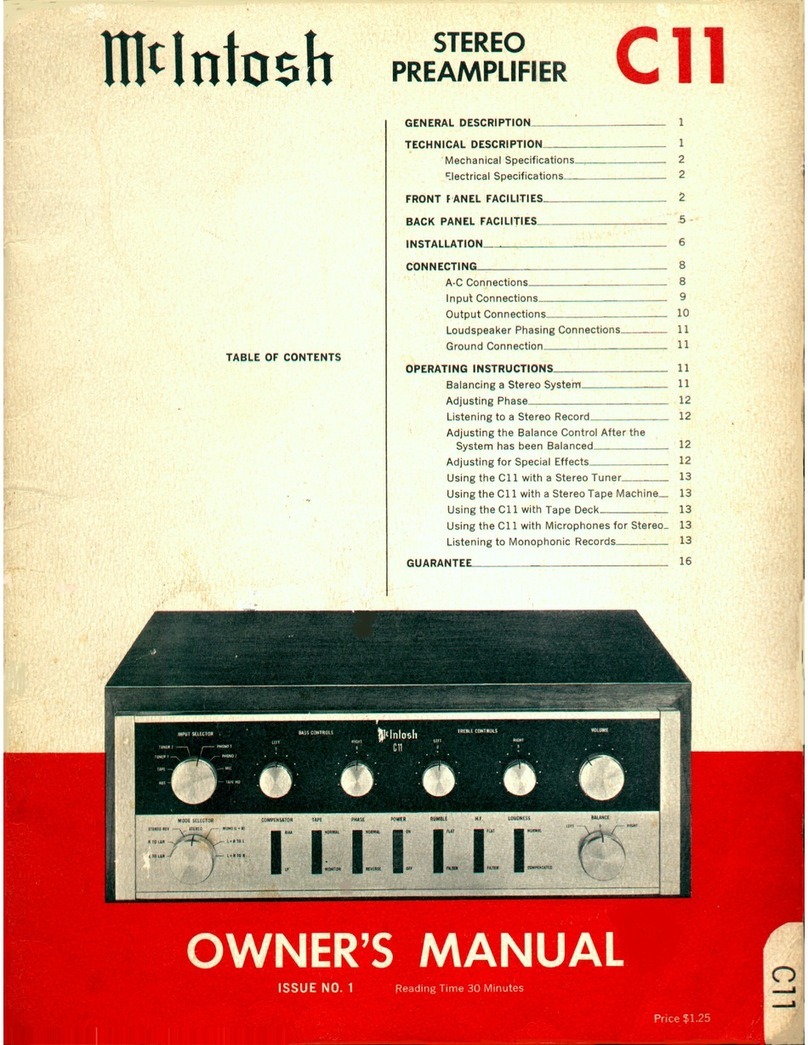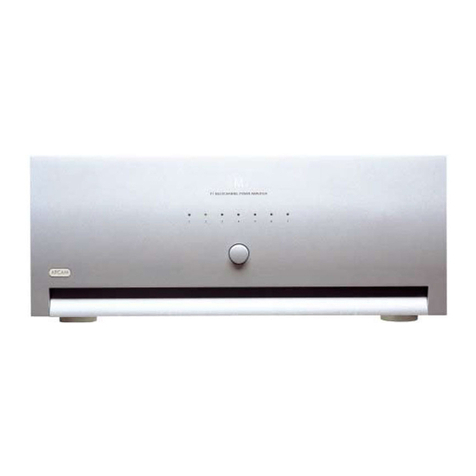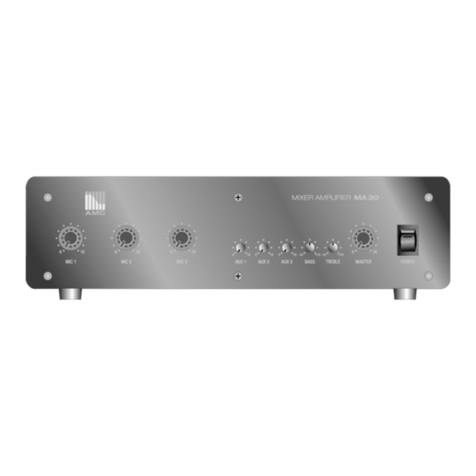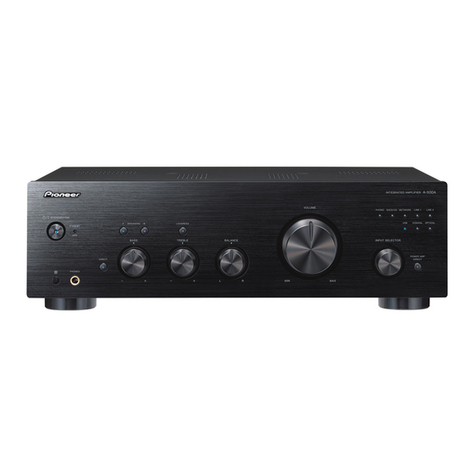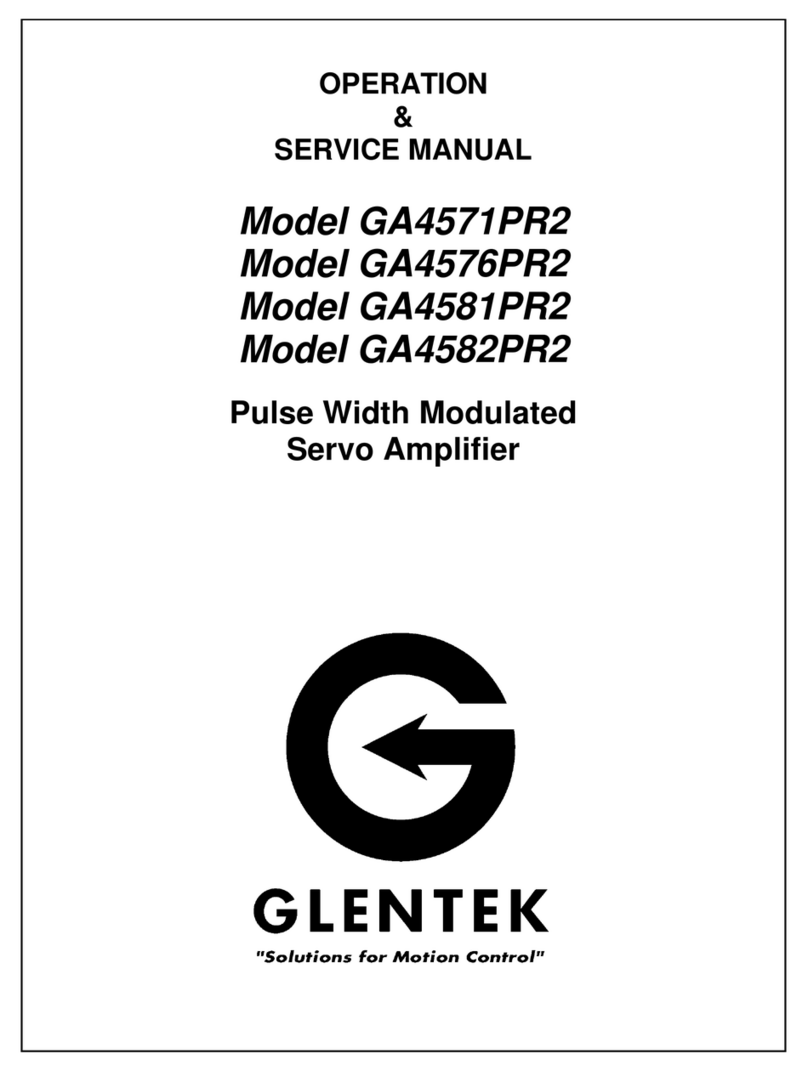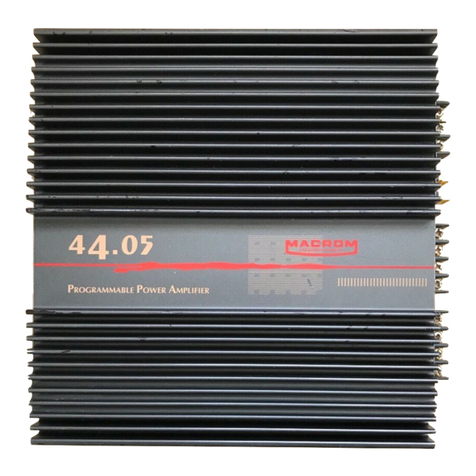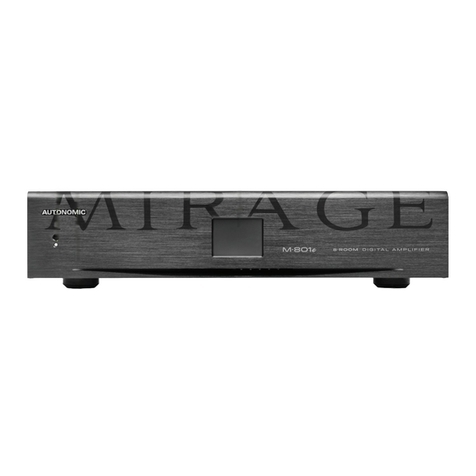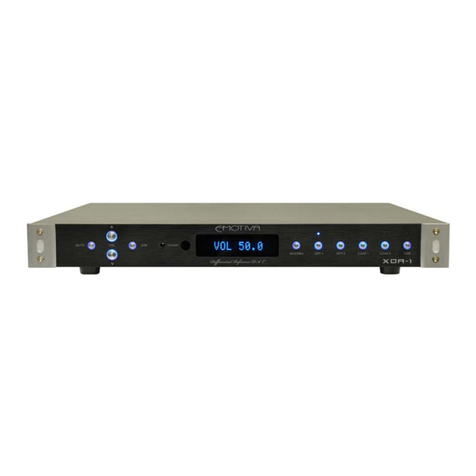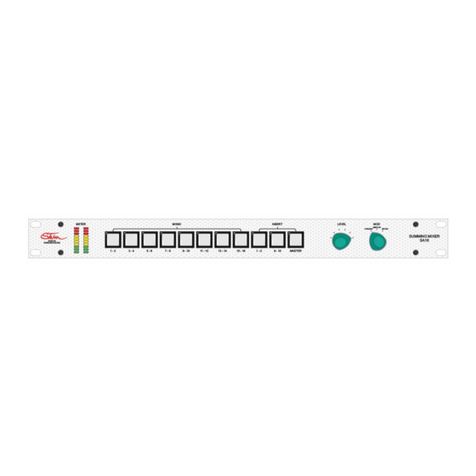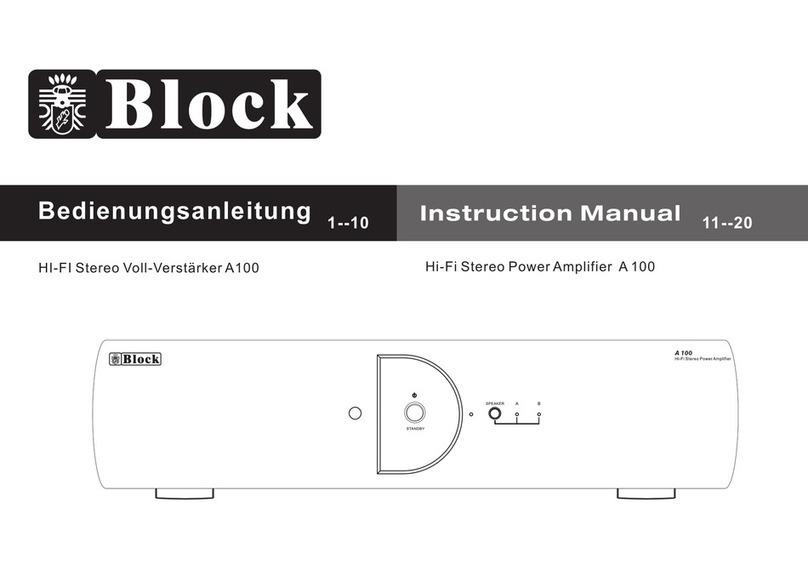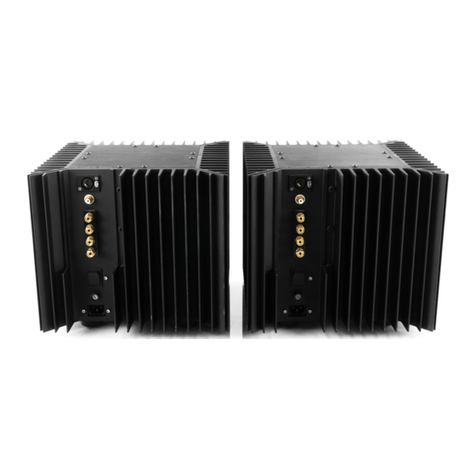Philps PM 3332 User manual

PHILIPS
PM
3332
LOW
DRIFT
HIGH
SENSITIVITY
WIDE
BAND
AMPLIFIER
66
405
64.1-10
1~1066~00~01

2
IMPORTANT
In
correspondence
concerning
this
apparatus,
please
quote
the
type
number
and
the
serial
number
as
given
on
the
type
plate
at
the
back
of
the
apparatus.

3
Contents
GENERAL
INFORMATION
VIII.
Circuit
description
13
L
Characteristics
5
A.
Input
circuit
B.
HF
amplifier
13
13
II.
Description
of
the
Block
Diagram
6
C.
DC
amplifier
13
D.
Interstage
network
13
DIRECTIONS
FOR
USE
E.
Chopper
amplifier
15
F.
Final
amplifier
16
III.
Installation
7
IV.
Functions
of
the
Controls
7
IX.
Checking
and
Adjusting
A.
Check
of
the
chopper
amplifier
17
17
A.
Input
7
B.
Grid
current
compensation
18
B.
Deflection
coefficient
8
C.
Balance
adjustment
19
C.
Bandwidth
8
D.
Square
-wave
response
19
D.
Shift
8
E.
Deflection
coefficient
20
E.
Gain
Adjustment
8
F.
Frequency
response
curve
20
V.
Applications
9
G.
Deflection
and
Shift
H.
AC/DC
switch;
Check
zero
20
20
I.
Input
attenuator
20
SERVICE
DATA
VL
Introduction
11
X.
List
of
service
parts
A.
Mechanical
parts
22
22
VIL
Principles
of
the
control
loop 12
B.
Electrical
parts
23
List
of
Figures
1
Schematic
diagram
of
the
controls
7
14
Left-hand
view
18
2
Input
terminal
and
controls
7
15
Pulser
19
3
Y
-deflection
coefficient
switch
8
16
Input
RC
standardiser
21
4
Bandwidth
selector
8
17
Printed
circuit
U
7
(Supply
filter;
27
5
Shift
control
8
18
Printed
circuit
U
8
(Final
stage)
27
6
Gain
adjustment
control
8
19
Printed
circuit
U
9
(Grid
circuit)
27
7
Voltage
measurement
9
20
Printed
circuit
U
10
(H.F.
amplifier)
27
8
Limits
of
the
Y
deflection
9
21
Printed
circuit
U
11
(Amplifier)
29
9
Controlloop
12
22
Frinted
circuit
U
12
(Chopper
Amp.)
27
10
Bandwidth
characteristics
14
23
Attenuator
circuit
30
11
Operation
of
the
cross
-over
filter
14
24
Chopper
amplifier
circuit
35
12
Operation
of
th
e
demodulator
15
25
Final
amplifier
circuit
41
13
Right-hand
view
17
26
HF
and
LF
amplifier
circuit
47

5
GENERAL
INFORMATION
The
PM
3332
is
an
H.F.
amplifier,
built
into
aplug-
in
unit
for
the
vertical
channel
of
basic
oscilloscope
PM
3330.
Owing
to
its
high
sensitivity
and
bandwidth,
the
unit
covers
a
wide
range
of
applications.
The
amplifier
is
chopper
-stabilised,
with
the
result
that
d.c.
drift
is~
eliminated.
Characteristics
Input
circuit
input
coupling
input
socket
input
impedance
maximum
permissible
d.c.
voltage
in
position
"AC"
Amplifier
zero
level
deflection
coefficient
Bandwidth
Noise
in
most
sensitive
position
at
bandwidth
0...50
Mc/s
at
bandwidth
0...100
kc/s
Rise
time:
at
maximum
bandwidth
Rise
time
of
the
unit
itself
Overshoot
Pulse
droop
Magnification
asymetrical
a.c.
or
d.c.
B.N.C.
1
M~
//
15
pF
400
V
Properties,
expressed
in
numerical
values
with
state-
ment
of
tolerances
are
guaranteed
by
the
factory.
Numerical
values
without
tolerances
are
intended
for
information
purposes
only
and
indicate
the
properties
of
an
average
apparatus.
The
numerical
values
hold
good
for
nominal
mains
voltages
unless
otherwise
stated.
0
by
means
of
apush-button
"CHECK
ZERO",
the
zero
level
can
be
checked
adjustable
to
12
calibrated
values,
i.e.:
500
µV
-
1
mV
-
2
mV/cm
etc.
to
2
V/cm,
tolerance
-~
-
3%
con-
tinuous
attenuation
1
:,
3
is
possible
(non
-calibrated)
d.c.:
0...50
Mc/s
("FULL")
or
0...100
kc/s
a.c.:
1.6
c/s...50
Mc/s
("FULL")
ar
1.6
c/s...100
kc/s
open
input
short-circuited
input
open
input
short-circuited
input
7
nsec.
5
nsec.
<
2%
<
3%
4
mm
3
mm
1.5
mm
0.4
mm
Up
to
10
X
the
useful
screen
height
(symmetrically
around
the
centre
of
the
screen)
Of
a
picture
that
has
been
magnified
to
3
X
the
usefull
scree
n
height
(symmetrical
around
the
centre
of
the
screen),
the
peaks
can
be
made
visible
by
means
of
the
shift
control

6
Drift
Triggering
of
the
time
base
required
picture
height:
Mechanical
data
Accessories
Optional
accessories
500
~V/week
3
mm
for
frequencies
up
to
10
Mc/s
10
mm
for
frequencies
up
to
30
Mc/s
1
cm
in
position
"AUT."
1
cm
video
signal
in
positions
"TV
LINE"
and
"TV
FRAME"
width
15
cm
depth
27.5
cm
(including
knobs
and
plug)
height
17.5
cm
weight
2
kg
Manual
measuring
probe
PM
9331
A/10
input
impedance
10
MSt
//
8
pF
attenuation
1
:
10,
tolerance
±
3%
maximum
permissible
voltage
1000
V
peak
Description
of
the
block
diagram
The
input
circuit
includes
an
"AC
-DC"
switch,
a
step
attenuator
("mV/cm
-
V/cm")
and
apush-button
"CHECK
ZERO".
The
step
attenuator
is
connected,
via
a
cathode
follo-
wer
stage,
to
two
parallel
connected
amplifiers,
an
a.c.
coupled
H.F.
amplifier
and
a
d.c.
coupled
L.F.
amplifier.
The
output
voltages
are
applied
to
an
out-
put
amplifier
via
a
cross
over
filter.
The
input
signal
of
the
output
amplifier
is
compared,
via
an
attenuator,
with
the
signal
on
the
input
of
the
cathode
follower
stage.
The
difference
voltage,
due
to
drift
in
the
d.c.
coupled
L.F.
amplifier,
is
converted
into
asquare-wave
vol-
tage
by
a
mechanical
chopper.
This
square
-wave
voltage
is
amplified
in
an
a.c.
coupled
amplifier
and
after
that
detected.
The
output
signal
of
the
detector
is
applied
to
the
d.c.
coupled
L.F.
amplifier,
with
the
result
that
drift
in
this
am-
plifier
is
heavily
fed
back.
The
output
amplifier
containsthe
continuous
gain
control,
the
"SHIFT"
control
and
a
screwdriver
ad-
justment
"GAIN
ADJ.".
The
output
voltage
of
the
output
amplifier
is
applied
to
the
vertical
amplifier
and
the
trigger
preamplifier,
via
the
Y
-plug.

7
DIRECTIONS
FOR
USE
1
MI2
15pF
Installation
The
PM
3332
should
be
slid
into
the
left-hand
com-
Switching
on
is
effected
via
the
mains
switch
of
the
partment
(Y
-unit)
of
the
basic
oscilloscope
PM
3330.
basic
oscilloscope.
AC
so
zo
CHECK
ZERO
O
v
BANDWIDTH
0-100kHz
FUEL
DC
coupled
LF
Amplifier
crass
over
filter
►~
Chopper
Amplifier
I
1/A
Attenuator
Output
Amplifier
Fig.
1.
Schematic
diagram
of
the
controls
Functions
of
the
controls
Fig.
1
A.
INPUT
m
The
input
socket
"1
Mil//
15
pF"
is
connected
to
the
step
attenuator
("mV/cm"
—
"V/cm")
via
switch
"AC
-DC".
In
position
"AC",
the
input
is
a.c.
coupled
to
the
attenuator;
in
position
"DC"
the
coupling
is
direct.
By
depressing
push-button
"CHECK
ZERO",
the
connection
between
the
step
attenuator
and
the
amplifier
is
cut-off
and
the
input
of
the
amplifier
is
earthed.
With
this
the
zero
level
of
the
amplifier
can
be
checked.
ont
Y
-PLUG
-r~-~I
Y
-Amplifier
GAINIADJ.
PEM
2891
CHECK
ZEs~
'.
w~T
AC
r
DC
IMn
t
~
isvr
~:
~~
s
►I
Trigger
Amplifier
Fig.
2.
Input
terminal
and
controls

8
B.
DEFLECTION
COEFFICIENT
The
deflection
coefficients
are
adjusted
by
means
of
the
attenuator
("mV/cm"
—
"V/cm").
These
deflec-
tion
coefficients
are
calibrated
if
the
continuous
gain
control
is
turned
fully
clockwise
(indicated
with
"CAL.").
C.
"BANDWIDTH"
The
maximum
bandwidth
is
obtained
by
setting
switch
"BANDWIDTH"
to
position
"FULL".
In
the
most
sensitive
position
of
the
attenuator,
a
noise
band
having
a
width
of
a
few
millimetres
will
appear
on
the
screen.
In
position
"0...100
kc/s"
of
switch
"BAND-
WIDTH",
the
bandwidth
of
the
amplifier
is
limited
to
the
indicated
value
at
which
the
noise
can
be
neglected.
Nate:
The
noise
is
also
reduced
while
maintaining
the
maximum
bandwidth,
by
reducing
the
sen-
sitivity
of
the
amplifier
by
means
of
the
attenu-
ator.
D,
"SHIFT"
The
picture can
be
shifted
in
a
vertical
direction
with
the
aid
of
knob
"SHIFT".
E.
"GAIN
ADJ."
The
deflection
coefficients
of
the
unit
can
be
checked
by
applying
the
calibration
voltage
of
the
basic
oscillo-
scope
to
the
input
of
the
unit.
If
the
deflection
co-
efficients
do
not
correspond
to
the
values
indicated
on
the
text
plate,
the
coefficients
can
be
corrected
by
means
of
setting
"GAIN".
Fig.
3.
Y
-deflection
coefficient
switch
Fig.
4.
Bandwidth
selector
Fig.
S.
Shift
control
Note:
With
this
adjustment,
the
continuous
gain
con-
trol
should
be
turned
fully
clockwise,
("CAL").
Fig.
6.
Gain
adjustment
control

9
Applications
0
Voltage
measurements
When
measuring
the
voltage
of
a
signal
use
is
made
of
the
calibrated
deflection
coefficients
of
the
vertical
deflection
system.
Using
the
control
elements
on
the
plug-in
unit
and
the
basic
oscilloscope,
adjust
to
a
triggered
trace.
1n
Fig.
7
the
peak
-to
-peak
value
amounts
to
3
X
20
mV
=
60
mV.
Note:
The
tolerance
of
the
deflection
coefficient
(3%)
can.
be
reduced
by
adjusting,
in
the
position
used,
the
deflection
coefficient
by
means
of
setting
"GAIN
ADJ.".
For
this,
the
calibration
voltage
of
the
basic
oscilloscope
can
be
used.
l~
r
Figure
8
indicates
the
maximum
magnification
(A)
and
the
part
of
the
magnified
signal
(B)
that.
can
be
displayed
on
the
screen
(C)
by
means
of
the
"SHIFT"
control.
Note:
When
loading
to
more
than
10
X
the
useful
screen
height,
the
amplifier
will
be
overloaded.
The
picture
then
obtained
is
no
longer
propor-
tional
to
the
input
voltage.
Fig.
7.
i
3cm
+
i
i
IA
I
I
I
I
I
I
I
I
I
I
I
I
I
I
I
I
i
I
Ig
L
Voltage
measurement
so
zo
V/c
m
~/
1
1
2
Fig.
8.
Limits
of
the
Y
deflection
PEM
2892

11
SERVICE
DATA
Introduction
The
pre
-amplifier
consists
of
an
AC
coupled
HF-
amplifier
and
a
DC
coupled
LF-amplifier
the
outputs
of
which
are
combined
by
a
cross
-over
filter.
The
latter
forms
ahigh-pass
filter
for
the
HF-amplifier
and
glow
-pass
filter
for
the
DC
-amplifier.
The
HF-
amplifier
has
a
bandwidth
from
300
Hz
to
100
MHz;
the
DC
-amplifier
has
a
bandwidth
from
DC
to
4
MHz.
The
—3dB
frequency
of
the
cross
-over
filter
lies
at
100
kHz.
In
this
way
asplit-band
amplifier
is
obtained
with
a
bandwidth
from
DC
to
100
MHz.
The
advantages
of
the
split
-band
amplifier
are:
a.
lower
noise
H.F.
transistors
suffer
from
a
serious
1
/f
noise
at
frequencies
lower
than
approx.
100
kHz.
L.F.
transistors
cause
a
serious
noise
at
higk~er
fre-
quencies.
Moreover,
they
do
not
meet
the
rise
-
time
requirements.
In
th
e
split
-band
amplifier
the
be
st
properties
of
the
transistors
are
used,
each
in
their
awn
frequency
range.
b.
better
DC
biasing
In
a
split
-band
amplifier
it
is
possible
to
adjust
the
transistors
to
their
optimum
collector
-current
i.e.
far
H.F.
transistors
to
approx.
10
mA,
for
L.F.
transistors
to
approx.
1
mA.
c.
No
necessity
for
constant
dissipation
networks
As
the
time
-constant
of
the
thermal
processes
in
m
the
H.F.
transistors
amounts
to
several
milli-
seconds
and
the
H.F.
amplifier
is
followed
by
a
100
kHz
high.
-pass
filter,
there
is
no
necessity
to
provide
the
H.F,
amplifier
with
constant
dissi-
pation
networks.
d.
Better
decoupling
of
the
supply
-voltages
As
RC
coupling
is
used,
it
is
only
necessary
to
have
one
common
power
supply.
The
supply
per
stage
is
sufficiently
decaupled
without
impairing
the
L.F.
square
-wave
response.
To
avoid
undue
interstage
coupling
the
emitter
resistors
are
con-
nected
to
earth.
It
is
possible
to
switch
off
the
AC'
amplifier
with
switch
SK1
sa
that
a
DC
amplifier
remains
with
a
bandwidth
of
0...100
kHz,
without
HF
noise.
At
the
4
smallest
deflection
coefficients
-
5
mV/cm
to
0,5
mV/cm
-the
amplification
factor
of
the
split
-
band
amplifier
is
increased
by
decreasing
the
negative
feedback.
A
convenient
deflection
can
be
selected
with
switch
SK4.
For
the
larger
values,
attenuator
networks
are
insert-
ed
between
the
input
terminal
and
the
pre
-amplifier.
The
DC
-amplifier
is
provided
with
a
control
circuit
(chopper
amplifier)
which
counteracts
DC
drift.
The
final
amplifier,
contrary
to
the
pre
-amplifier,
is
entirely
push-pull
connected.
The
output
of
the
final
amplifier
is
routed
to
both
the
Y
-amplifier
and
the
trigger
amplifier
of
the
basic
oscilloscope.

12
Principles
of
the
control
-loop
The
input
circuit
of
the
DC
amplifier
consists
of
a
differential
amplifier.
Input
I
receives
signal
V
;
;
input
II
receives
the
control
signal
V,..
All
drift
-
voltages
are
refered
to
input
I
where
they
are
as-
sumed
to
come
from
avoltage-source
V
ii
(Fig.
9).
Output
V„
of
the
DC
-amplifier
is
attenuated
by
a
factor
A
at
the
1/A
attenuator.
At
one
side
of
voltage
divider
R1
—
R2
=
1.11
Mohm,
voltage
V
;
is
fed
in
and
at
the
other
side
voltage
V~/A;
there-
fore,
the
input
of
the
chopper
amplifier
will
be
(Vs
-~
V~/A)•
After
amplification,
control
voltage
V~
amounts
to:
At
terminal
I
the
input
stage
of
the
DC
-amplifier
receives
a
voltage
equal
to
V
;
+
V~~
and
at
termi-
Fig.
9.
Controlloop
nal
II
voltage
V~.
The
difference
is
amplified
(—A)
times
so
output
V
o
amounts
to:
extracting
V~
gives:
As
B
~
2000,
it
is
clear
that
drift
V,
i
is
reduced
by
a
factor
,-
~
1000.
If
SK3
is
in
position
"AC",
capacitor
0102
is
inserted
in
series
with
R1
so
voltage
divider
R1
—R2
is
blocked
for
DC.
Any
leakage
voltage
of
C26
is
added
to~
V~~
but
now
the
"new"
drift
voltage
V~'
will
1
be
reduced
by
a
factor
1
+
B

13
Circuit
descripfion
A.
INPUT
CIRCUIT
(Fig.
23}
When
the
AC
—DC
switch
SK3
is
in
position
"AC"
it
is
possible
to
observe
small
AC
signals
super-
imposed
on
a
maximal
400
V
DC
-voltage.
At
the
same
time
relay
RE
101
is
energised
which
switches
capacitor
C102
into
comparison
circuit
R1
—R2
(Fig.
9).
In
this
way
any
DC
component
at
the
input
circuit
which
may
be
due,
among
other
things,
to
the
leakage
of
C26,
is
compensated
by
the
action
of
the
chopper
amplifier.
In
the
"AC"
position
of
SK3,
blocking
capacitor
C26
may
be
charged
by
a
DC
input
voltage.
On
switching
over
to
position
"DC"
the
capacitor
is
discharged
to
prevent
the
charge
of
C26
from
destroying
any
delicate
test
object
when
switching
aver
again
from
DC
to
AC.
When
the
step
attenuator
is
put
at
the
4
smallest
deflection
-coefficients
(0,5,
1,
2,
5
mV/cm)
the
input
signal
is
not
attenuated.
Trimmers
C18
-C21
-C24
-C29
allow
the
input
capacitance
to
be
adjusted
to
precisely
15
pF.
For
the
larger
deflection
coefficients,
attenua-
tor
networks
are
inserted
between
the
input
terminal
and
the
cathode
follower
B101.
With
trimmers
C33
-
C36
-C39
-C43
-C47
-051
-054
-058,
the
input
capaci-
tance
can
be
adjusted
to
15
pF.
Trimmers
C32
-C34
-
C38
-C42
-C46
-C49
-053
-057
allow
an
adjustment
for
optimum
square
-wave
response.
The
1.11
Mohm
resistor
consists
of
the
resistors
R103
(1
Mohm)
and
R102
(110
Kohm).
This
value
is
choosen
to
obtain
a
1
Mohm
input
resistance
because
agrid-current
compensating
network
with
a
10
Mohm
source
resistor
(R104)
is
connected
at
this
point,
and
it
is
parallel
to
the
1.11
Mohm
resistance.
The
grid
-current
compensating
network
consisting
of
resistors
R106
-R107
-R110
-R115
and
potentiometer
R108
delivers
a
positive
or
negative
current,
de-
pending
on
the
position
of
R108.
This
current
is
required
for
cathode
follower
stage
B101,
Which
supplies
the
input
signal
to
the
split
-band
amplifier
via
overload
-protecting
diodes
GR104-GR106.
Push-button
SK2
disconnects
the
input
signal
and
earthen
the
grid
of
the
cathode
-follower,
to
indicate
the
zero
-level
of
the
display.
Diodes
GR101
and
GR102
protect
the
chopper
amplifier
when
the
DC
part
of
the
split
-band
ampli-
fier
is
overdriven.
B.
HF-AMPLIFIER
(Fig.
26}
The
AC
components
of
the
input
signal
are
fed
into
the
HF
amplifier
via
emitter
-follower
TS102.
The
three
nearly
identical
stages
consist
of
an
ordinary
emitter
-amplifier
and
an
emitter
-follower.
Each
stage
provides
an
output
which
is
in
anti
-phase
with
respect
to
its
input.
As
a
whole
the
HF-amplifier
provides
a
180
degrees
phase
-shift
to
match
the
output
of
the
DC
-amplifier.
In
the
positions
"
2
-
1
-
.5
mV/cm"
of
SK4
the
gain
of
the
H.F.
amplifier
is
increased
by
decreasing
the
current
feedback
respectively
at
the
3rd,
2nd
and
1st
stage.
At
these
positions
of
SK4
the
gain
can
be
matched
to
that
of
the
DC
amplifier
by
selecting
resistors
as
tabulated
below.
Position
Resistor
of
SK4
Coarse
Fine
5
mV/cm
2
mV/cm
1
mV/cm
.5
mV/cm
8138
R173
R158
R143
R139
R174
R159
R144
If
the
measurements
permit
this,
the
HF-amplifier
can
be
taken
out
of
operation
by
throwing
switch
SK1
which
cuts
off
only
the
power
supply
of
the
second
stage.
C.
DC
-AMPLIFIER
(Fig.
26p
The
DC
and
LF-components
of
the
input
signal
enter
the
DC
coupled
amplifier
at
the
base
of
T5113,
which
is
part
of
difference
amplifier
TS112
-
TS114.
The
correction
voltage
delivered
by
the
chopper
-
amplifier
enters
at
the
other
emitter
-follower
(TS111).
The
difference
of
the
two
signals
is
fed,
via
emitter
-
follower
TS116,
to
two
more
stages,
which
consist
of
an
amplifier
and
an
emitter
-follower.
At
the
last
stage,
zener-diode
GR107
provides
a
low
impedance
step-down
of
the
DC
level.
When
the
most
sensitive
deflection
coefficients
are
selected,
SK4
reduces
the
emitter
resistance
of
TS117
thus
increasing
stepwise
the
overall
gain
of
the
DC
-
amplifier
from
10
x
to
25
x,
50
x
and
100
x.
An
exact
match
with
the
1/A
attenuator
can
be
carried
out
by
adjusting
patentio~meter
R208.
D.
INTERSTAGE
NETWORK
(Fig.
26)
The
outputs
of
the
HF-amplifier
and
the
DC
ampli-
fier
are
combined
in
cross
-over
filter
R216
-
C157
and
fed
to
emitter
-follower
TS401.
The
1/A
attenua-
tor
is
connected
to
the
emitter
of
TS401.
It
consists
of
precision
resistors
R406
-
R408
-
R409
-
R411
and
R412.
Its
output
is
fed
to
the
chopper
amplifier
via
the
1.11
Mohm
resistors
R300
-
R301.
The

14
continuous
gain
control
R2
is
also
connected
to
the
emitter
of
TS401.
The
output
impedance
of
the
two
amplifiers
is
very
small
compared
with
the
impedance
of
R216
—
C157.
This
means
that,
seen
from
the
HF
amplifier
C157
+
R216
act
as
a
high-passfilter
with
a
cross-
over
frequency
of
100
kHz,
thus
suppressing
law
frequency
noise
components
and
other
spurious
low
frequency
signals,
generated
in
the
HF
amplifier
(Fig.
10).
Seen
from
the
LF
amplifier,
however,
R216
-~-
C157
act
as
a
law
-pass
filter
with
a
cross-
over
frequency
of
100
kHz,
suppressing
high
fre-
quency
noise
components
and
other
high
frequency
signals
generated
in
the
LF
amplifier.
An
input
signal
V
;
applied
to
the
split
-band
amplifier
(see
Fig.
11)
causes
an
output
signal
a
l
V
;
at
"a"
and
an
output
signal
a
2
V
;
at
"b"
(a
7
and
a
2
de-
noting
the
gain
of
respectively
the
HF
amplifier
and
the
LF
amplifier).
vD
~
~v~~
,
0.0)
0
05
0.03
ooz
001
10°
D.C.AMPL
aFILTER
10
1
10z
1
FILTER
//
10
3
10~
0-4
MHz
(DC
-AM
PL.)
Fig.
10.
Bandwidth
characteristics
Vi►
At
frequencies
where
a
l
cv
a2
cv
a
(a
denoting
the
desired
overall
gain)
the
output
at
"a"
equals
the
output
at
"b",
thus
no
current
will
flow
through
the
interstage
network.
Than
the
output
at
"C"
equals
a
V
;
.
At
low
frequencies,
a
7
is
smaller
th
an
a
z
and
a~
equals
a.
Now
the
output
at
"a"
is
smaller
than
the
output
at
"b"
sa
a
current
will
fl
ow
through
R216
and
C157,
which
causes
R216
—
C157
to
act
as
a
law
-pass
filter
to
the
output
at
"b".
As
a
2
V
;
=
aV
;
the
output
at
"C"
equals
the
output
at
"b".
At
high
frequencies,
a
2
is
smaller
than
a
l
and
a
l
equals
a.
Now
the
output
at
"b"
is
smaller
than
the
output
at
"a",
so
a
current
will
flow
through
R216
and
C157,
which
causes
R216
—
C157
to
act
as
a
high-pass
filter
to
the
output
at
"a".
As
a
l
V
;
=
aV
;
the
output
at
"c"
equals
the
output
at
"a".
~~LTER
10
5
t0
6
10
7
300Hz-100
MHz
(HF
AMPL.)
HF
a1
y
C157
7
LF
a2
R126
C
PEM
3267
H
F
AMP
L.
7pB
PEM
37fi3
Fig.
ll.
Operation
of
the
cross
-over
filter

15
E.
CHOPPER
AMPLIFIER
(Fig.
24}
The
chopper
amplifier
consists
of:
1.
the
400
Hz
oscillator
2.
the
chopper
3.
the
amplifier
4.
the
demodulator.
The
oscillator
is
an
inductively
fed
-back
push-pull
oscillator
which
is
tuned
to
400
Hz
by
fixed
capaci-
tor
C313
and
the
adjustable
inductance
of
trans-
former
L302.
lts
output
drives
the
chopper
directly,
and
the
demodulator
via
aphase-shifting
network.
A
DC
voltage
caused
by
the
drift
is
applied
to
termi-
nal
1
of
the
chopper.
The
latter
switches
the
input
of
the
amplifier
alternately
to
this
voltage
and
earth
(at
terminal
3)
so
the
input
receives
a
square
wave
voltage.
In
order
to
avoid
hum,
the
earthing
of
the
chopper
is
carried
out
at
a
single
point
near
input
cathode
-follower
B
101.
The
square
-wave
input
-signal
is
amplified
about
120x
in
stage
TS301
—
TS302
—
TS303,
the
AC
-
amplification
being
determined
mainly
by
the
relation
R311
:
R309.
The
DC
-amplification
is
determined
by
the
relation
R311
:
(R309
~-
R308)
which
amounts
to
about
1
:
1.
The
next
stage
consisting
of
TS304
—
TS306
gives.
a
further
20x
amplification
for
AC,
but
a
2
:
1
reduc-
tion
for
DC;
so
DC
-variations
have
hardly
any
influence
an
the
stability
of
the
control
circuit.
Via
emitter
-follower
TS306,
the
chapped
signal
is
fed
to
the
phase
-sensitive
detector
which
contains
the
symmetrical
NPN
transistors
TS307
—
TS308
—
TS309
—
TS311.
The
driving
voltage
of
the
detector
is
generated
at
two
separate
windings
of
transformer
L301
which
receives
its
primary
voltage
from
the
chopper
driving
source.
~
C302
JI
AMPL
0307
R102
R103
R300
R
301
-Vi
Vd
1+1/2
B
By
the
action
of
the
collector
-to
-base
diode
of
the
transistors
a
biasing
voltage
builts
up
across
capaci-
tors
C308
and
C309,
the
charge
of
which
can
leak
away
across
resistors
R322
and
R323.
During
the
crests
of
the
sinusoidal
driving
voltage
the
charge
is
supplemented
until
the
biasing
voltage
equals
the
driving
voltage,
sa
during
those
times
abase
-current
exists,
which
makes
the
transistors
conductive.
In
this
way,
there
is
a
change
-over
switch
which
operates
synchronous
with
the
chopper;
network
R332
—
C317
provides
the
necessary
phase
-shift
to
be
sure
that
the
contact
is
made
when
the
top
of
the
square
-wave
is
steady.
In
the
simplified
diagram
(Fig.
12)
the
demodulator
is
represented
by
a
switch
which
connects
capacitor
C307
to
capacitor
C311
or
earth.
The
switch
makes
a
momentary
contact
under
influence
of
the
earlier
mentioned
biasing
voltage.
From
Fig..
12
it
is
clear
that
the
polarity
of
the
voltage
over
C311
will
be
inverse
to
that
of
the
input
voltage,
due
to
the
phase
reversal
of
the
amplifier.
The
amplitude
virtually
equals
the
peak
to
peak
value
of
the
amplifier
output
being
insensitive
to
variations
of
the
mean
value,
which
could
be
caused
by
variations
of
the
chopper
duty
cycle.
As
the
output
may
be
either
positive
or
negative,
symmetrical
transistors
are
used
for
the
demodulator
as
they
allow
a
bidirectional
current
flow
as
long
as
base
-current
is
present.
The
AC
earthing
of
the
demodulator
is
carried
out
by
capacitor
C164.
Po-
tentiometer
R187
allows
the
balance
adjustment
of
the
differential
(first)
stage
of
the
DC
amplifier.
Once
correctly
adjused,
the
balance
will
be
maintained
by
the
control
-circuit.
The
interconnection
of
the
1.11
Mohm
resistors
can
be
seen
as
a
virtual
earth
and,
as
a
consequence,
the
input
resistance
of
the
DC
-amplifier
will
not
change
due
to
the
action
of
the
chopper
amplifier.
Vc=Vd
1/2
B
1+1/2
B
PEM
3141
Fig.
12.
Operation
of
the
demodulator

16
F.
FINAL
AMPLIFIER
(Fig.
25}
The
input
stage
of
the
final
amplifier
consists
of
an
asymmetrically
driven
long-tailed
pair.
The
sigpal
enters
via
emitter
-follower
TS402
at
the
base
of
TS404.
The
shift
control
enters
via
TS403
at
the
base
of
TS40~6.
At
the
emitter
side
of
the
long-tailed
pair,
screw-
driver
-set
potentiometer
R1
enables
a
vernier
adjust-
ment
of
the
deflection
coefficient.
With
trimmer
C416
the
rise
-time
can
be
adjusted
to
optimum.
The
output
stage
is
provided
with
two
complementary
pairs
of
emitter
-followers.
They
allow
for
both
fast
rise
and
fall
when
displaying
a
squarewave,
in
spite
of
the
capacitance
load,
pre-
sent
at
the
input
of
the
Y
-amplifier
and
the
trigger
-
amplifier.
The
signals.
enter
via
forward
biased
diodes
whose
standing
current
can
be
adjusted
by
R449
respecti-
vely
R457.
If,
for
instance,
the
voltage
at
the
col-
lector
of
TS404
rises,
the
current
through
GR403
decreases
and
the
current
through
GR404
increases.
This
gives
rise
to
an
increase
of
the
base
-current
of
the
NPN
transistor
TS407
which
will
became
more
condictive;
so
the
output
will
become
mare
positive.
The
increase
of
the
current
through
GR404
causes
a
decrease
of
the
base
-current
of
PNP
transistor
TS408,
which
will
become
less
conductive,
offering
a
higher
impedance
to
the
NPN
emitter
-follower.
As
a
whole,
the
capacitance
present
at
the
output
of
the
final
amplifier
will
be
charged
rapidly
from
a
low
ohmic
current
source.
At
the
time
that
the
voltage
at
the
collector
of
TS404
rises,
the
voltage
at
the
collector
of
TS406
falls.
The
current
through
GR406
will
decrease,
thus
opening
PNP
transistors
TS409.
The
output
capacitance
will
be
discharged
rapidly
through
this
law
ohmic
path.
The
output
voltage
of
the
final
amplifier
is
offered
directly
to
the
Y
-amplifier
of
the
basic
oscilloscope
via
terminals
1BU-Y
and
17BU-Y.
The
trigger
-
amplifier
receives
the
same
voltages
via
R236
an
d
R237
next
to
terminals
16BU-Y
and
32BU-Y.

17
Checking
and
adjusting
GENERAL
INFORMATION
The
tolerances
mentioned
are
factory
tolerances;
they
apply
when
the
apparatus
is
readjusted
completely.
They
may
differ
from
the
data
given
in
chapter
I.
A
summary
of
the
adjusting
elements,
their
nomen-
clature
and
location
has
been
given
in
chapter
IV.
With
the
aid
of
these
data,
it
is
possible
to
carry
out
all
the
adjustments
of
low
drift
unit
PM
3332
and
to
check
the
proper
working
of
the
plug-in
unit.
For
this
the
unit
should
be
inserted
into
the
'Y
-plug-in
compartment
of
a
correctly
adjusted
basic
oscillo-
scope
PM
3330.
Some
of
the
adjusting
elements
are on
the
right-hand
side
of
the
unit
and
are
not
directly
accessible.
When
these
elements
should
be
adjusted,
the
unit
should
be
connected
to
the
basic
oscilloscope
via
the
rigid
ex-
tension
plug
(for
the
code
number
of
this
plug,
see
the
list
of
accessories
of
PM
3330).
For
a
complete
adjustment
of
the
instrument
the
se-
quence
as
described
in
this
chapter
is
to
be
preferred.
13
A.
CHECK
OF
THE
CHOPPER
-AMPLIFIER
It
is
possible
to
remove
the
chopper
-amplifier
from
its
housing
after
removing
lid
"A"
(Fig.
13)
and
a
four
pin
plug,
a
three
pin
plug
and
a
single
pin
plug.
If
measurements
are
carried
out.
when
the
amplifier
is
out
of
its
housing,
it
should
be
carefully
screened
to
avoid
hum.
—
Connect
the
positive
pole
of
a
24
V
supply
to
earth
and
to
the
green
wire
on
the
4
pin
plug.
The
negative
pole
should
be
connected
to
the
black
wire
on
the
4
pin
plug.
—
Adjust
the
oscillator
frequency
to
approx
400
Hz
by
screwing
in
or
out
the
core
of
coil
L302.
—
Apply
a
1
mV
negative
voltage
(with
the
aid
of
a
suitable
voltage
divider
and
the
12
V
power
supply
or
a
separate
dry
cell)
to
pin
"1"
of
the
3
-pin
plug.
Connect
pin
"
2"
to
the
"common"
of
the
voltage
divider
and
earth.
pin
"
3"
by
connec-
ting
it
to
the
green
wire
of
the
4
-pin
plug.
Fig.
13.
Right-hand
view

18
—
Apply
aload-resistance
of
1
Mohm
to
the
2
re-
maining
pins
of
the
4
-pin
plug.
The
voltage
de-
veloped
across
this
resistance
should
amount
to
a
value
between
2
and
2.5
V.
The
brawn
wire
should
be
negative
with
respect
to
the
orange
one.
—
Increase
the
input
voltage
to
3
mV.
The
output
should
be
equal
to
5
V
or
exceed
that
value.
—
Change
the
polarity
of
the
input
voltage;
the
out-
put
voltage
should
be
equal
to
or
exceed
5
V,
if
possible,
equal
to
the
value,
stated
at
the
pre-
vious
measurement.
—
Remove
the
voltage
from
the
3
-pin
plug
and
inter-
connect
pin
"
2"
and
pin
"
3".
The
output
should
be
equal
to
or
smaller
than
20
mV.
—
The
noise
across
resistor
R317
should
be
<
10
mVrms.
—
Remove
the
interconnection.
Now
the
noise
may
not
exceed
50
mVrms.
Note:
If
one
of
the
last
two
requirements
is
nat
met,
the
input
transistor
TS301
(2N930)
should
be
replaced.
U8
B.
GRID
-CURRENT
COMPENSATION
R108
(Fig.
14)~
Set
the
knobs
of
the
basic
oscilloscope
to
the
following
positions:
"TRIGG.
MODE"
"TRIGG.
SOURCE"
"'TIME/cm"
"X
-DEFLECTION"
"AUT"
"INT"
"5
msec./cm"
"TIME
BASE
A"
—
At
the
unit,
set
"V/cm"
(SK4)
to
"0.5mV/cm"
and
(R2)
to
"CAL.".
—
Adjust
"SHIFT"
(R3)
so
that
the
trace
is
in
the
middle
of
the
screen.
Short
circuit
the
input
con-
nector.
Adjust
"Ig. COMP"
(R108)
so
that
the
trace
does
not
jump
when
button
"CHECK
ZERO"
(SK2)
is
depressed.
Input
Capacitors
Square
Wave
Response
Fig.
14.
Left-hand
view

19
C.
BALANCE
ADJUSTMENT
R187
(Fig.
l3)
Before
carrying
out
this
measurement
connect
unit
PM
3332
to
the
basic
oscilloscope
with
the
extension
cable
(see
list
of
accessories
of
PM
3330).
—
Set
"V/cm"
(SK4)
to
"0,5
mV/cm".
Keeping
"CHECK
ZERO"
(SK3)
depressed,
turn
"V/cm"
(R2)
quickly
to
and
fro.
If
the
trace
is
moving
vertically,
adjust
R187
until
the
trace
is
stationary.
D.
SQUARE
WAVE
RESPONSE
R208
(Fig.
13).
C416
(Fig.
13)
R138
-R139
-R143
-R144
1
R158
-R159
-R173
-R174
(Fig.
21)
Apply
the
rigid
extension
plug
and
set
"V/cm"
(SK4)
to
"5
mV/cm".
Turn
potentiometers
"GAIN
ADJ"
(Rl)
and
"V/cm"
(R2)
fully
anticlockwise;
set
"AC
-
DC"
(SK3)
to
"DC".
—
Apply
a
square
wave
with
a
10
Hz
repetition
fre-
quency
and
such
an
amplitude
as
to
obtain
a
4
cm
trace
height.
Adjust
R208
to
that
the
square
wave
has
a
flat
top.
Increase
the
frequency
to
100
kHz
with
an
am-
plitude
of
20
mV
p
_
~,.
To
obtain
an
optimum
square
-wave
response
the
gain
of
the
H.F.
ampli-
fier
should
be
made
equal
to
that
of
the
DC
am-
plifier.
This
can
be
obtained
by
changing,
the
value
of
several
emitter
resistors
according
to
the
next
table.
PEM
3296
Position
of
SK3
Amplitude
of
the
100
kHz
signal
Choice
resistor
coarse
fine
5
mV/cm
20
mV
p
_
p
R138
R139
2
mV/cm
8
mV
T
,_
n
R174
R173
]
mV/cm
4
mV
n
_
P
R159
R158
0.5
mV/cm
2
mV
n
_
P
R144
R143
Note:
With
choice
resistor
"coarse"
adjust
the
display
so
that
some
rounding
off
is
present;
with
choice
resistor
"fine"
adjust
the
display
so
that
just
no
overshoot
occurs.
—
Remove
the
extension
plug
and
apply
a
square
wave
with
a
1.5
nsec.
rise
time.
This
can
be
obtained
by
connecting
atunnel-
diode
pulse
shaper
to~
the
calibration
voltage.
If
a
Tektronix
TU-5
unit
(cat.
number
Ol
5-0038-00)
is
used,
it
should
be
adapted
to
the
80
V
cali-
bration
voltage
by
connecting
a
2700
ohm
(0.1
Watt,
5%)
resistor
parallel
to
the
3300
ohm
re-
sistor
of
the
unit
(see
Fig.
15).
Connect
the
pulser
to
the
input
terminal
of
the
amplifier
via
a
5
:
1
and
a
2%
:
1
attenuator
(e.g.
Tektronix
011-0060-00
resp.
011-0076-00)
and
a
50
ohm
termination
pad.
(e.g.
XE
101.96).
—
Set
the
knobs
of
the
basic
oscilloscope
to
the
following
positions:
"TRIGG.
MODE"
"H.F."
"TRIGG.
SOURCE"
"INT"
"TIME/cm"
:0.05
nsec/cm
"MAGN"
x
5
—
Set
the
knob
of
the
PM
3332
"V/cm"
(SK4)
to
"5
mV/cm".
—
With
trimmer
C416
adjust
for
a
minimum
rise
time.
ols-o3a
TU-S
PULSER
TEKTRONIX,
INC.
2700
n
.1
Watt
5
°
~0
to
be
added
Item
16
of
fig.
I4
Fig.
I5.
Pulser

20
E.
DEFLECTION
COEFFICIENT
—
Set
"V/cm"
(SK4)
to
"5
mV/cm"
and
"V/cm"
(R2)
to
"CAL.".
—
Apply
a
20
mV
calibration
voltage
to
the
input
of
the
plug-in
unit.
—
Adjust
"GAIN
ADJ."
(R1)
so
that
the
trace
-
height
amounts
to
precisely
40
mm.
—
It
should
be
possible
to
reduce
the
trace
height
to
less
than
16
mm
with
"V/cm"
(R2).
F.
FREQUENCY
RESPONSE
CURVE
After
adjusting
the
square
wave
response
(point
D)
and
the
deflection
coefficient
(point
E)
the
—3
dB
point
of
the
unit.
should
lie
at
a
frequency
of
more
than
50
MHz.
The
frequency
response
curve
can
be
measured
with
e.g.
the
PHILIPS
A.M./F.M.-generator
GM
2621
and
the
PHILIPS
H.F.-millivoltmeter
GM
6025.
The
latter
is
to
check
that
the
input
voltage
remains
con-
stant
at
the
various
frequencies.
—
Set
"X
-deflection"
(SK7)
on
thebasic
oscilloscope
to
"50
Hz".
—
Set
"V/cm"
(SK4)
on
the
unit
to
"5
mV/cm"
and
"V/cm"
(R2)
to~
"CAL.".
—
Connect
the
output
connector
HF
II
with
a
ter-
minated
50
-Ohm
cable
to
a
T
-piece
which
takes
in
the
HF
probe
of
the
millivoltmeter.
Apply
the
T
-piece
to
the
input
terminal
of
the
plug-in
unit.
—
Switch
the
generator
frequency
to
10
MHz
and
adjust
the
voltage
to
a
40
mm
trace
height.
Note
the
indication
of
the
millivoltmeter.
—
Increase
the
frequency
to
50
MHz
and
adjust
the
amplitude
to
the
same
value
as
noted
before.
—
The
trace
height
should
exceed
28
mm.
G.
DEFLECTION
AND
SHIFT
Before
carrying
out
this
measurement,
check
that
the
DC
balance
and
the
sensitivity
have
been
correctly
adjusted
(see
point
C
and
E).
—
Set
the
"AC/DC"
switch
(SK3)
to~
"AC",
"V/cm"
(SK4)
to
"5
mV/cm"
and
"V/cm"
(R2)
to
"CAL.".
—
Set
"TIME/cm"
on
the
basic
oscilloscope
to
"0.2
msec/cm".
—
Apply
a
triangular
(or
sinusoidal)
signal
with
a
frequency
of
2
kHz
and.
an
amplitude
of
90
mV~,
_
P
.
—
The
control
range
of
"SHIFT"
(R3)
should
be
so
large,
that
the
tops
of
the
trace
can
be
brought
within
the
measuring
graticule.
—
With
this
triple
overdriving,
no
distortion
of
the
trace
should
occur.
H.
AC/DC
SWITCH;
CHECK
ZERO
Set
the
below
mentioned
knobs
to
the
following
positions:
"AC/DC"
(SK3)
to
"DC"
"V/cm"
(SK4)
to~
"5
mV/cm"
"V/cm"
(R2)
to
"CAL.".
—
Apply
a
20
mV
calibration
voltage
to
the
input
of
the
plug-in
unit.
—
Adjust
"SHIFT"
(R3)
so
that
the
lower
side
of
the
trace
coincides
with
the
centre
line
of
the
screen.
—
Set
SK3
to
"AC".
The
DC
components
of
the
calibration
voltage
should
be
blocked,
as
a
result
of
which
the
trace
is
written
approximately
symmetrically
around
the
centre
li
ne
of
the
screen.
—
Slowly
depress
button
"Check
Zero"
(SK2).
First
the
signal
should
be
visible
in
its
differen-
tiated
form
and
next,
it
should
disappear
com-
pletely.
L
INPUT
ATTENUATOR
1.
Attenuation
and
square
wave
response
For
the
adjustment
of
the
attenuator,
in
every
posi-
tion
of
"V/cm"
(SK4),
the
corresponding
trimmers
are
accessible
via
holes
in
the
screening
plate
(see
Fig.
14).
—
Apply
the
calibration
voltage
of
thebasic
oscillo-
scope
to
the
input
of
the
PM
3332.
—
After
correct
adjustment
of
the
deflection
coeffi-
cient
(see
point
E)
the
trace
height
should
amount
to
precisely
40
mm.
—
Check
the
trace
height
in
all
other
positions
of
SK4
according
to
the
table
below;
the
trace
height
should
amount
to
40
mm,
+
or
—
2%.
—
At
the
same
time,
adjust
the
trimmers
mentioned
in
the
table
for
optimum
square
wave
response.
Calibration
voltage
V/cm
(SK4)
Trimmer
2
mV
0.5
mV/cm
4
1
8
2
20
5
40
10
C31
80
20
C34
0.2
V
50
C38
0.4
0.1
V/cm
C42
0.8
0.2
C46
2
0.5
C49
4
1
C53
8
2
C57

2.
Input
capacitance
With
the
aid
of
an
input
RC
standardiser
(Fig.
16)
(e.g.
Tektronix
cat.
number
011-0073-00
BNC)
the
input
capacitance
can
be
adjusted
to
15
pF
in
all
positions
of
SK4.
—
Apply
the
calibration
voltage
of
the
basic
oscillo-
scope
to
the
input
of
the
unit
via
the
input
RC
standardiser.
—
Adjust
the
input
capacitance
by
means
of
the
trimmers
mentioned
in
the
tabel
below
so
that
the
square
wave
response
is
optimum.
BN
6CONNECTOR
W4
101
96
21
Calibration
voltage
V/cm
(SK4)
Trimmer
4
mV
0.5
mV/cm
C18
8
1
C21
20
2
C24
40
5
C29
80
10
C33
0.2
V
20
C36
0.4
50
C39
0.8
0.1
V/cm
C43
2
0.2
C47
4
0.5
C51
8
1
C54
20
2
C58
~isp~n
iM
n
7
ii
r
Fig.
16.
Input
RC
standardiser
BNC-CONNECTOR
WC
101
66
PEM
2873

22
Lisf
of
service
parfs
A.
MECHANICAL
PARTS
D
Item
Fig.
Code
number
Description
Qty.
s
1
13
4822
454
40035
Textplate
1
*~
2
14
W4
125
73
Connector
1
3
13
979/5
x
180
Socket
1
4
13
4822
211
00854
Plug
i
5
13
4822
159
00445
Push
button
1
*~
6
13
4822
273
30133
Switch
SK1
1
7
13
4822
273
70013
Switch
SK4
1
8
13
4822
265
40037
Plug
(panel)
1
9
13
4822
159
00321
Knob
1
~~
10
13
4822
159
00318
Knob
1
**
11
13
4822
159
00359
Knob
1
*~
12
13
4822
159
00358
Cap
1
*~
13
13
4822
159
00315
Knob
1
**
14
13
4822
159
00314
Cap
2
*a
15
14
4822
105
30039
Unit
4
(Attenuator)
1
•
16
14
4822
214
10032
Unit
6
(Output
adjustment)
1
17
14
4822
214
10033
Unit
7
(Supply
filter)
1
18
13
4822
214
10034
Unit
11
(Amplifier)
1
19
13
4822
214
10035
Unit
12
(Chopper
amplifier)
1
PURPOSE
OF
THE
COLUMN
"S"
—
Components
not
marked
They
should
be
present
at
the
Service
ll
epartment
the
country
concerned
or
at
the
customer
who
is
using
the
apparatus.
'They
include:
a.
all
electrical
components;
b.
mechanical
parts
which
are
vulnerable,
or
which
are
subject
to
wear.
—
Components
marked
with
one
star
These
components
generally
have
a
long
or
unlimited
service
-life,
but
their
presence
is
essential
for
the
correct
working
of
the
apparatus.
Stocking
up
of
a
few
of
these
components
depends
on
the
following
factors:
in
a.
the
number
of
equipment
present
in
the
country
concerned;
b.
the
necessity
of
having
the
apparatus
working
con-
tinuously
or
not;
c.
the
time
of
delivery
of
the
components
with
respect
to
the
import
restrictions
in
the
country
concerned
and
the
duration
of
the
transport.
—
Components
marked
with
two
stars
These
components
have
along
or
unlimited
service
-
life
and
they
are
not
essential
for
the
correct
working
of
the
apparatus.
Generally
they
are
not
stocked
locally.
Table of contents
